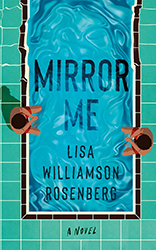Something Wild is a first novel that weaves its spell subtly. Its author, Hanna Halperin, introduces us to a pair of sisters, Nessa and Tanya Bloom, who seem, like the sisters in fairy tales, to be opposites. Tanya is rigid, efficient, bone-skinny, smart, a no-nonsense prosecutor. She is married to Eitan, an exemplary, reliable Jewish doctor from a traditional Orthodox family. Nessa, though two years older than Tanya, is unformed, wistful, untethered, self-loathing, and lost. Despite her fraught emotional journeys from lover to lover, she never seems to find simple affection, much less lasting love. It seems fitting that the book begins with Nessa aching from a sexually-induced urinary tract infection, and her practical sister, Tanya, providing her with an antibiotic prescription from Eitan.
Nessa is not the family member suffering in the most blatant emotional and physical ways. Tanya and Nessa’s mother, Lorraine, a poignant, unsophisticated Catholic woman has been left by her husband. Broken, she eventually marries a seductive man, Jesse, who turns out to be a violent physical abuser. Her girls had experienced an idyllic, but brief, childhood, in which their Jewish father, Jonathan, kept up with cozy traditions — all of which fall away when he leaves their mother for a younger, prettier woman. Now, as a “wilder” era begins, we find Nessa and Tanya dealing with a mother who is regularly beaten and choked by her new husband, but who somehow keeps coming back for more.
The girls, themselves, know something about wildness — even when young, they would chase each other, grabbing and tickling one another to the point of shrieking hysteria. Living liminally between order and chaos, they have grown up observing marriage turn to betrayal, and passion to punches in the face. Needy Nessa instantly trusts and bonds with her mother’s seemingly nice new husband; tense Tanya sees Jesse for what he is — a man on the dangerous edge of wildness.
These sisters, Halperin hints, have themselves suffered a severe sexual trauma in their past, one that their mother’s deadly bond gradually retriggers. Slowly and carefully, the author reveals what happened to the girls in their early teens, and why the family legacy of playing with danger seems so tantalizing to them all. There is an uncanny connection, Halperin implies, between sexual magic and destructive wildfire, and the boundaries between the two are sometimes difficult to maintain.
As Something Wild builds to a climactic ending, we feel more and more connected to the fixed points of life, which Halperin places for us throughout the book, like stepping stones. Eitan’s reliability and kindness suggests a love object who, though perhaps less exciting than a thuggish lady’s man, promises the stability of a permanent family. But the chief source of continuity lies with the sisters themselves. For although this novel takes us on a troubling journey to the edges of wildness, the tender, intimate, and honest bond between Nessa and Tanya manages to carry us to the safer shores of love.





